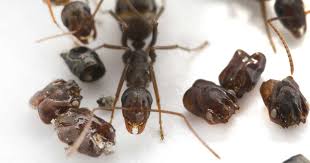There is a species of ant that could be considered one of the most grotesque out there because of its unusual choice of home decor—the decapitated heads of their victims.
Source: Newsweek
Scientific studies have consistently found Formica archboldi ants tend to keep lots of old body parts around their abodes. “A lot of ants are very clean, they’ll remove dead workers or left over food scraps,” said Adrian Smith, the Head of the Evolutionary Biology and Behavior Research Lab at North Carolina Museum of Natural Sciences.
Many ants carry their waste away, to outside the nest, and put it in a pile named a midden, which also functions as a cemetery. The main idea for having a clean nest is to protect the queen from infection.
However, the Formica ants “leave, for whatever reason, a big portion of their garbage in their nest,” says Smith, who has he examined these insects for two years and produced a study in 2019 on his findings.
“When you crack open their nests and you find a lot of body parts—it’s probably because they haven’t dumped their trash.”
Native to Florida, these skull-collecting ants particularly like devouring trap-jaw ants (Odontomachus brunneus)—typically not an easy target. Trap-jaws have a potent sting and spring-loaded bite, which is how they got their English name. Read more
Unlike other ants, Formica’s do not have a stinger. Instead, they spray a dose of formic acid at their victims, a load that can completely incapacitate a trap-jaw ant. “One spray can knock out a trap-jaw ant and one individual Formica ant could take down a whole trap-jaw ant, a remarkable feat considering that trap-jaw ants are usually known [as a] ferocious predator,” says Smith.
The majority of a Formica’s diet is trapdoor ants. “at a guess they would take down two or three workers a day,” Smith said. And the skulls are not digested or decomposed easily: “They’re the harder part of the exoskeleton, they’re all hollowed out, all the muscle has gone, it’s just the head cases, or skulls,” he said. “They’re kinda like discarded chicken bones.”
Another theory is that Formica keeps the remains around to chemically mimic the trap-jaw ant they feed on. “When they touch each other with their antennas they are actually smelling,” says Smith. “One way of acquiring the chemical, if they don’t manufacture it themselves, is perhaps by keeping the carcasses they acquire to maintain the smell of those ants.”
Despite scientists discovering these little creatures almost a century ago, it’s only recently that stories about them have been widely shared.
“There are rich details all around us that we overlook, or don’t pay attention to,” says Smith. “These guys have always been in Florida, but they are unique, we’ve known about these ants and their weird collections of body parts since the 1930s, but no one has taken the time to study them. These studies give us a reason to appreciate these things, show what’s out there and admire and protect them.”
Source: Newsweek

































Leave a Comment
You must be logged in to post a comment.